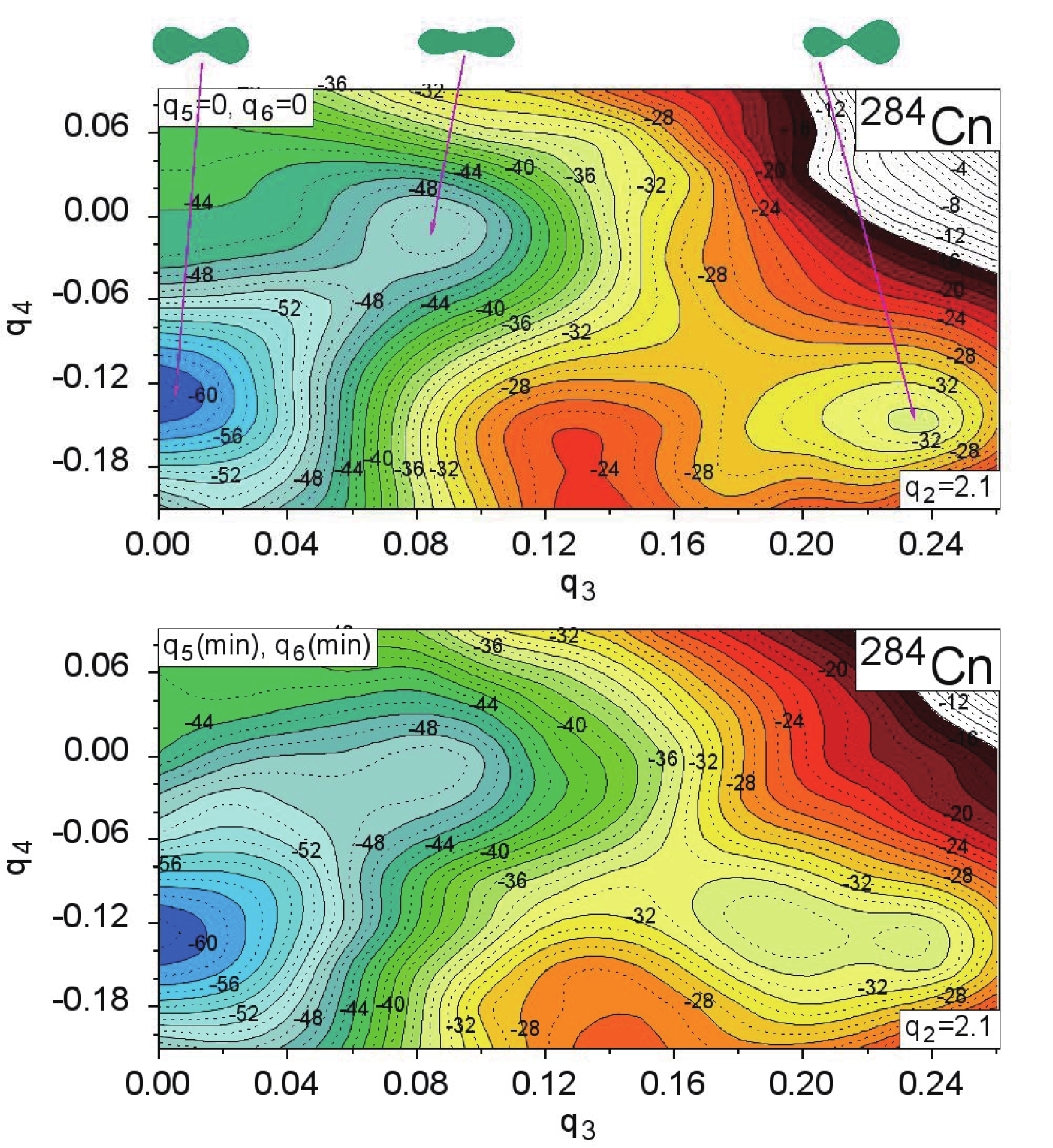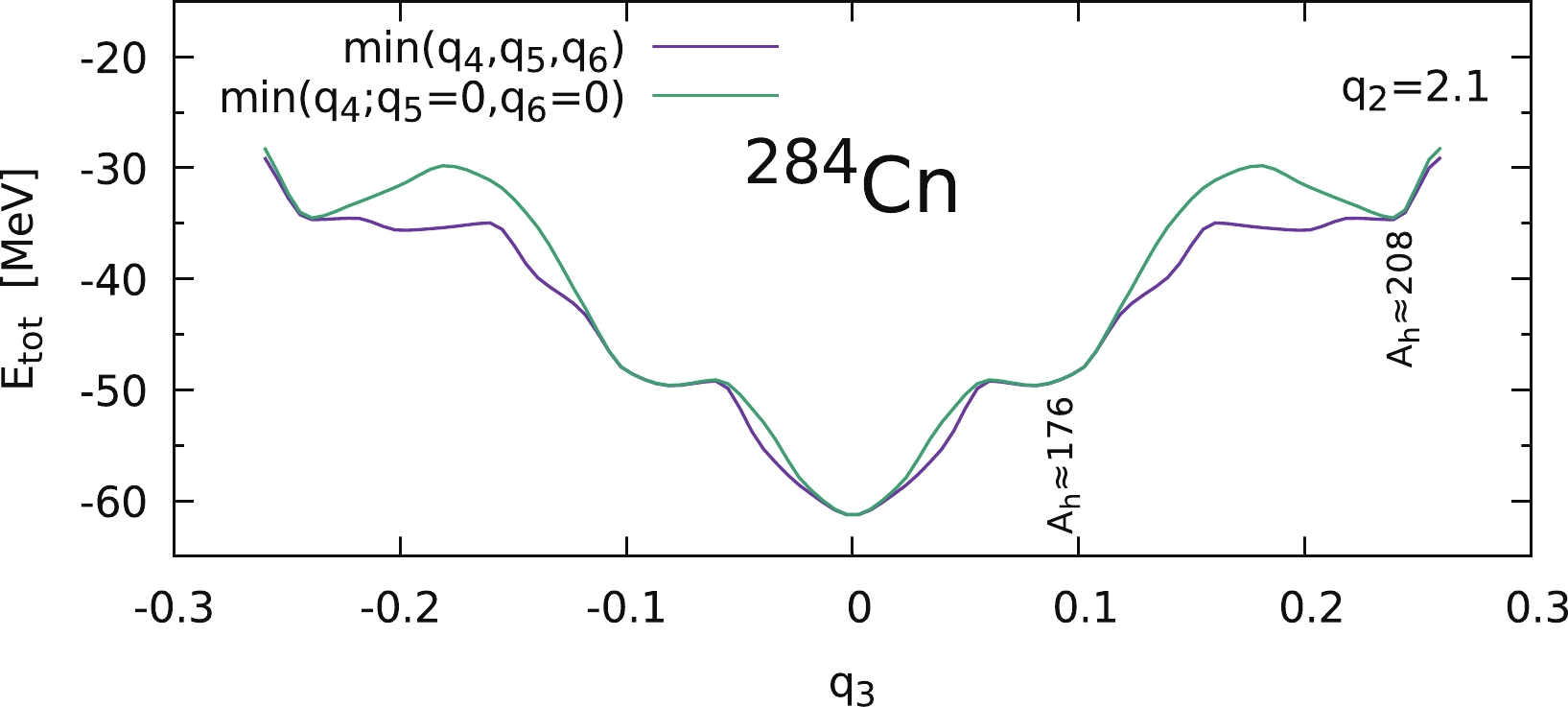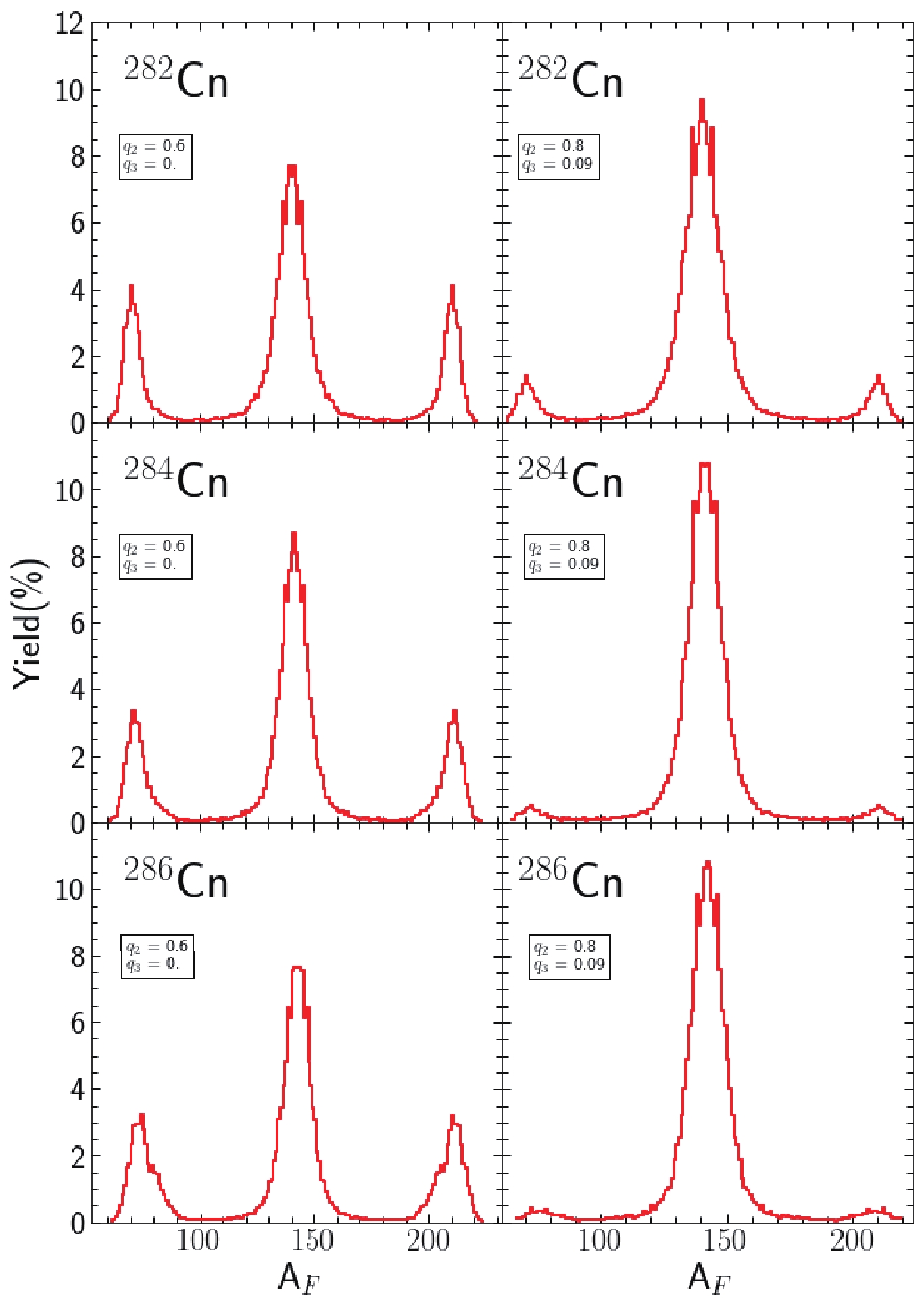HTML
--> --> -->Superheavy nuclei [1,2] with a charge number Z of up to 118 have been produced by two types of fusion reactions. The first is cold fusion at GSI, Germany [3,4], and RIKEN, Japan [5], which uses the doubly magic target
This study is a continuation of our work on the fission fragment mass yields of even-even Ra-Th and actinide nuclei [21-23], in which we presented a macroscopic-microscopic (mac-mic) model based on the Lublin-Strasbourg Drop (LSD) formula [24] and demonstrated that the Yukawa-folded single-particle potential [25] effectively describes fission barrier heights and fission fragment mass yields (FMY). In the present study, we aim to predict the fission barrier heights and FMY of SHN using the same set of model parameters. The calculation is performed in 4D Fourier deformation parameter space [26,27].
The Born-Oppenheimer+Wigner model used in Ref. [22] is not expected to describe a situation with two competing fission modes. Therefore, in this study, we evaluate FMY by solving 3D Langevin equations, similar to that in Ref. [23] done for some actinides. This alteration is because, in some isotopes of SHN, our mac-mic model predicts two well-separated fission valleys: one corresponding to symmetric fission and the other corresponding to asymmetric fission, which leads to heavy fragments around
This paper is organized in the following way. Section II presents details of the theoretical models used in the present study, Section III shows the collective potential energy surface evaluated within the mac-mic model for the selected isotopes and our fission barrier height estimates, Section IV contains the estimated FMY, and conclusions and perspectives from further investigations can be found at the end of the paper.
2
A.Fourier nuclear shape parametrization
The axial symmetric shape-profile function of a fissioning nucleus written in cylindrical coordinates $\begin{aligned}[b] \frac{\rho^2_s(u)}{R_0^2} = & a_2\cos(u)+a_3\sin(2u)+a_4\cos(3u)\\& +a_5\sin(4u) + a_6\cos(5u)+\dots, \end{aligned} $  | (1) |
$ \left\{ \begin{array}{ll} q_2 = a_2^{(0)}/a_2 - a_2/a_2^{(0)}\; ,& q_3 = a_3\; , \\[1ex] q_4 = a_4+\sqrt{(q_2/9)^2+(a_4^{(0)})^2}\; ,&\\[1ex] q_5 = a_5-(q_2-2)a_3/10\; ,& \\[1ex] q_6 = a_6-\sqrt{(q_2/100)^2+(a_6^{(0)})^2} &\;\;. \end{array} \right. $  | (2) |
Non-axial shapes can easily be obtained assuming that, for a given value of the
$ \varrho^2(z,\varphi) = \rho^2_s(z) \frac{1-\eta^2}{1+\eta^2+2\eta\cos(2\varphi)} \quad {\rm with} \quad \eta = \frac{b-a}{a+b}\; , $  | (3) |
2
B.Macroscopic-microscopic model
In the mac-mic method, first proposed by Myers and ?wi?tecki [28], the total energy of the deformed nucleus is equal to the sum of the macroscopic (liquid-drop type) energy and the quantum energy correction for protons and neutrons generated by shell and pairing effects $ E_{\rm tot} = E^{}_{\rm LSD}+ { E_{\rm shell}} + { E_{\rm pair}} \; . $  | (4) |
$ { E_{\rm shell}} = \sum\limits_k e_k - \widetilde E \; . $  | (5) |
${E_{{\rm{pair}}}} = {E_{{\rm{BCS}}}} - \sum\limits_k {{e_k}} - {\tilde E_{{\rm{pair}}}}.$  | (6) |
$ E_{\rm BCS} = \sum\limits_{k>0} 2e_k v_k^2 - G\left(\sum\limits_{k>0}u_kv_k \right)^2 - G\sum\limits_{k>0} v_k^4 -{\cal E}_0^\varphi\;, $  | (7) |
$ {\cal E}_0^\varphi = \frac{\displaystyle\sum\limits_{k>0}[ (e_k-\lambda)(u_k^2-v_k^2) +2\Delta u_k v_k +Gv_k^4] / E_k^2}{\displaystyle\sum\limits_{k>0} E_k^{-2}}\;. $  | (8) |
$ \begin{aligned}[b] \tilde E_{\rm pair} =& {-\frac{1}{2}\,\tilde{g}\, \tilde{\Delta}^2+\frac{1}{2}\tilde{g}\,G\tilde{\Delta}\, {\rm arctan}\left(\frac{\Omega}{\tilde\Delta}\right) -\log\left(\frac{\Omega}{\tilde\Delta}\right)\tilde{\Delta}}\\& { +\frac{3}{4}G\frac{\Omega/\tilde{\Delta}}{1+(\Omega/\tilde{\Delta})^2}/ {\rm arctan}\left(\frac{\Omega}{\tilde{\Delta}}\right)-\frac{1}{4}G }\; , \end{aligned} $  | (9) |
$ \tilde\Delta = {2\Omega\exp\left(-\frac{1}{G\tilde{g}}\right)}\; . $  | (10) |
$ G = {\frac{g_0}{{\cal N}^{2/3} \, A^{1/3}}}\; . $  | (11) |
In our calculation, the single-particle spectra are obtained by diagonalization of the s.p. Hamiltonian with the Yukawa-folded potential [25,36] using the same parameters as in Ref. [37].
2
C.Multidimensional Langevin equation
To study the fission dynamics of atomic nuclei, we use the Langevin equation formalism, which determines the motion of the nucleus in the multidimensional space of deformation parameters $ \left\{ \begin{aligned} {\dfrac{{\rm d}q_i}{{\rm d}t} = }& {\displaystyle\sum\limits_{j} \left[\mathcal{M}^{-1}\right]_{ij}p_j,}\\[3ex] {\dfrac{{\rm d}p_i}{{\rm d}t} = }& {-\dfrac{\partial V}{\partial q_i}-\dfrac{1}{2}\displaystyle\sum\limits_{jk} {\left[\dfrac{\mathcal{M}^{-1}}{\partial q_i}\right]_{jk}}p_jp_k} \\[3ex] & {+ \displaystyle\sum\limits_{jk}\gamma_{ij} \left[\mathcal{M}^{- 1} \right]_{jk}p_k + \sum_{j} g_{ij} \Gamma_j \; ,} \end{aligned} \right. \; $  | (12) |
The inertia tensor is calculated within the incompressible and irrotational liquid drop model using the Werner-Wheeler approximation [39]. For the nuclear surface described by the function
$ \mathcal{M}_{ij}(q) = \pi \rho_m \int\limits_{z_{\min}}^{z_{\max}} \rho^2_s(z,q) \left[ A_i A_j + \frac{1}{8}\rho^2_s(z, q )A_i' A_j' \right] {\rm d} z \; . $  | (13) |
$ A_i = \frac{1}{\rho^2_s(z, q)}\frac{\partial}{\partial q_i}\int_{z}^{z_{\max}} \rho^2_s (z', q) {\rm d}z' \; , $  | (14) |
During the fission process, the temperature of the nucleus changes due to the existence of friction forces. To take this effect into account, another type of the potential must be used, known as the temperature dependent Free Helmholtz energy
$ F(q) = V(q) - a(q)T^2\; ,$  | (15) |
$ T = \sqrt{E^*/a(q)}\; . $  | (16) |
The collective potential in Eq. (4) in the mac-mic approximation is given by the sum of the macroscopic and the microscopic parts
$ V_{\rm mic}(q, T) = {\frac{V_{\rm mic}(q, T = 0)}{1 + e^{(1.5 - T)/0.3}}}\; . $  | (17) |
$ \gamma^{\rm mic}_{ij} = {\frac{0.7\cdot\gamma^{\rm wall}_{ij}} {1+e^{(0.7-T)/0.25}}}\; , $  | (18) |
$ \gamma^{\rm wall}_{ij} = \frac{\pi}{2} \rho_m \bar{v} \int\limits_{z_{\min}}^{z_{\max}} \frac{\partial \rho^2_s}{\partial q_i} \frac {\partial \rho^2_s}{\partial q_j} \left[ \rho^2_s + \frac{1}{4} \left (\frac {\partial \rho^2_s}{\partial z} \right)^2 \right]^{-1/2} {\rm d}z,$  | (19) |
The final term of the second equation in Eq. (12) represents the random Langevin force. Its amplitude
$ \bar{\xi} = 0, \: \bar{\xi}^2 = 2\; , $  | (20) |
The diffusion tensor is obtained using the Einstein relation
$ D_{ij} = \sum_k g_{ik} g_{jk} = \gamma_{ij} \cdot T\; , $  | (21) |
$ T^* = \frac{E_0}{2} \coth \frac{E_0}{2 T}\; , $  | (22) |
The irrotational flow inertia tensor (Eq. (13)) and the wall friction tensor (Eq. (19)) are evaluated using the Fortran codes published in Ref. [45].
In Appendix A, the cross-sections
In the top panel of Fig. 1, the (
 Figure1. (color?online)?Potential energy surface of
Figure1. (color?online)?Potential energy surface of The nucleus
In the bottom panel of Fig. 1, the
The maps presented in the Appendix for
 FigureA1. (color?online)?Potential energy surface of
FigureA1. (color?online)?Potential energy surface of  FigureA2. (color?online)?The same as in Fig. A1 but for
FigureA2. (color?online)?The same as in Fig. A1 but for  FigureA3. (color?online)?The same as in Fig. A1 but for
FigureA3. (color?online)?The same as in Fig. A1 but for  FigureA5. (color?online)?The same as in Fig. A1 but for
FigureA5. (color?online)?The same as in Fig. A1 but for  FigureA6. (color?online)?The same as in Fig. A1 but for
FigureA6. (color?online)?The same as in Fig. A1 but for  FigureA7. (color?online)?The same as in Fig. A1 but for
FigureA7. (color?online)?The same as in Fig. A1 but for  FigureA8. (color?online)?The same as in Fig. A1 but for
FigureA8. (color?online)?The same as in Fig. A1 but for  FigureA9. (color?online)?The same as in Fig. A1 but for
FigureA9. (color?online)?The same as in Fig. A1 but for As a regular article does not contain sufficient space to discuss the details of the
 Figure2. (color online) Fission barrier heights of even-even superheavy nuclei evaluated in our 4D mac-mic model. The ground-state energy for Rf isotopes is taken as zero, while for each subsequent element, it is shifted by 2 MeV. The barrier plots are also shifted by the same amount. The ground state energy values corresponding to each element are marked on the r.h.s. vertical scale. The experimental data for the lower limit of the barrier heights [53] are marked by crosses and arrows of the same colors as the element symbols.
Figure2. (color online) Fission barrier heights of even-even superheavy nuclei evaluated in our 4D mac-mic model. The ground-state energy for Rf isotopes is taken as zero, while for each subsequent element, it is shifted by 2 MeV. The barrier plots are also shifted by the same amount. The ground state energy values corresponding to each element are marked on the r.h.s. vertical scale. The experimental data for the lower limit of the barrier heights [53] are marked by crosses and arrows of the same colors as the element symbols.The barrier heights are evaluated using the flooding technique in 4D space. The results for each element, starting from Rf to Z = 120, are indicated by different colors. The ground-state energy for Rf isotopes is taken as to zero, and for each subsequent element, this is shifted by 2 MeV. In other words, one has to subtract
The maximum barrier height for each element varies; this value is 7 MeV for Rf to Ds nuclei, reaches 9 MeV for
A question to consider is whether our 4D deformation space (
 Figure3. (color?online)?The
Figure3. (color?online)?The The PES cross-section of
 Figure4. (color?online)?PES cross-section corresponding to the elongation
Figure4. (color?online)?PES cross-section corresponding to the elongation Our group presented similar estimates of the SHN barrier height in Ref. [60]. The main difference between those and the present results originates mainly from a better and more accurate description of the pairing correlation effect (see Eqs. (7)–(9)), as well as using a denser and more extended 4D mesh in the deformation parameter space.
All deformation dependent transport coefficients in Eq. (12) were stored for each nucleus at equidistant (
The Langevin calculation of each
$ \begin{aligned}[b] E_{\rm coll} =& {V(q_3,q_4;q^{\rm start}_2)-V(q^{\rm start}_3,q^{\rm start}_3; q^{\rm start}_2)}\\&+ {\frac{1}{2}\sum\limits_{i = 3,4;j = 3,4}{\cal M}_{ij}p_ip_j = E_0} \; , \end{aligned} $  | (23) |
The Langevin trajectory proceeds randomly towards fission within the following rectangular 3D box with the collective variables:
$ \begin{aligned}[b] q^{\rm start}_2 \leqslant & q_2 \\ -0.27\leqslant & q_3 \leqslant 0.27\\ -0.21 \leqslant & q_4 \leqslant 0.21 \end{aligned} $  | (24) |
 Figure6. (color online) Fission fragment mass yields of six Ds isotopes. The l.h.s. column corresponds to the case in which the Langevin trajectories begin in the vicinity of the saddle point (low energy fission), while the r.h.s. columns present the estimates made for the spontaneous fission when the trajectories begin around the exit point from the barrier.
Figure6. (color online) Fission fragment mass yields of six Ds isotopes. The l.h.s. column corresponds to the case in which the Langevin trajectories begin in the vicinity of the saddle point (low energy fission), while the r.h.s. columns present the estimates made for the spontaneous fission when the trajectories begin around the exit point from the barrier. Figure7. (color?online)?The same as in Fig. 6 but for Cn isotopes.
Figure7. (color?online)?The same as in Fig. 6 but for Cn isotopes. Figure8. (color?online)?The same as in Fig. 6 but for Fl isotopes.
Figure8. (color?online)?The same as in Fig. 6 but for Fl isotopes.Our Langevin estimates of the fission fragment mass yields of
 Figure5. (color online) Fission fragment mass yield (red solid line) estimate for the
Figure5. (color online) Fission fragment mass yield (red solid line) estimate for the In Fig. 6, the fission fragment mass yields of the
 FigureA4. (color?online)?The same as in Fig. A1 but for
FigureA4. (color?online)?The same as in Fig. A1 but for Figures 7 and 8 show similar estimates of the FMY for the
The potential energy surfaces of 18 even-even isotope chains of elements from Rf to Z = 126 have been carefully studied, and the flooding technique was used to determine the fission barrier heights. An essential role of the non-axial and left-right asymmetry degrees of freedom was shown when evaluating the barrier heights. The minimum energy path to fission of the heaviest spherical and oblate nuclei from this region goes frequently via highly oblate and then non-axial shapes, leading to a significant decrease in their barrier heights.
A detailed investigation of PES suggests that the dominant fission channel of SHN (apart from the lightest isotopes of Rf to Hs) is symmetric. In addition, in nuclei with A
At larger elongations (
As seen in Figs. A1-A3, all shown isotopes of Rf, Sg, and Hs are prolate in the ground-state. This is due to the deformed shell effect previously reported in 1990 by Patyk and Sobiczewski [63]. The microscopic energy correction in the ground-state is approximately –3 MeV in Rf isotopes, and becomes larger in Sg nuclei, reaching –4.5 MeV for
